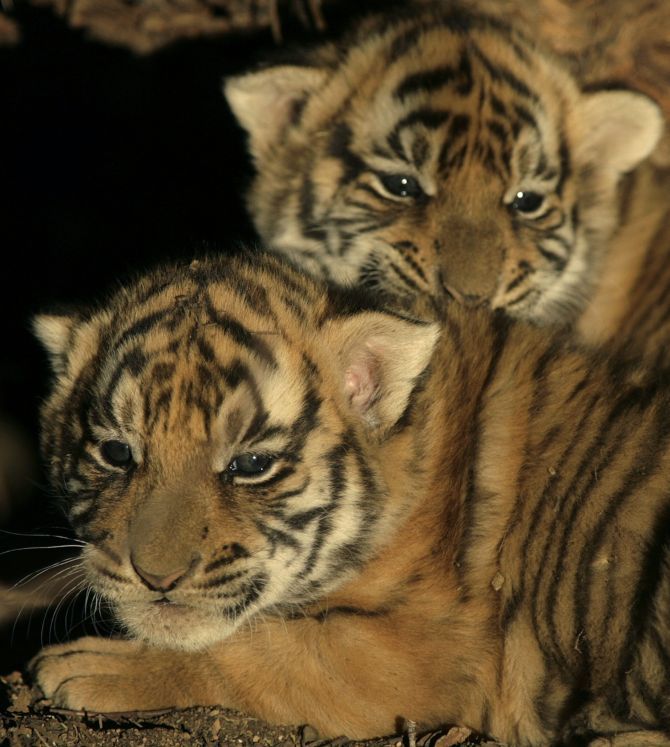Counting discrepancies could make a huge difference in classifying the Project Tiger a success or a failure, notes Pallava Bagla.

How many tigers are there in India? According to the most recent government estimate, it is 2,226.
Extrapolations from scientific ground estimates could make the number swing between nearly 1,500 and 3,000, a swing like this can make a difference in classifying the high profile Project Tiger a success or a failure and hence estimates are crucial for policy formulation.
Not all agree on this figure of 2,226. Wildlife experts use different techniques to estimate tiger populations. Experts from the government’s Wildlife Institute of India, Dehradun, have suggested that in central India’s most famous tiger habitat Kanha National Park, some estimates could be higher by as much as 30 per cent.
Yadvendradev Jhala, a well-known tiger researcher from WII, writes in a published scientific paper that experts using DNA fingerprinting techniques had estimated the tiger number in Kanha to be 89, while another scientific technique that relies on camera traps gave a much lower estimate of 60.
No doubt tigers are reclusive animals and counting them is not easy but such a huge discrepancy of a third of the population casts a doubt on the reliability of both the
techniques.
Speaking at the tiger summit in April, Prime Minister Narendra Modi had said, “India has a long standing and successful track record of protecting its tigers. We launched Project Tiger in 1973. Its coverage has increased considerably from the initial nine tiger reserves to 49 at present. Tiger conservation is a collective responsibility of the government of India and states... Our cultural legacy which encourages compassion and co-existence has played an important role in the success of Project Tiger. Due to such collective efforts, there has been a rise of thirty per cent in the number of tigers. It has gone up from 1,706 in 2010 to 2,226 in 2014.”
The same meeting of global tiger experts held in New Delhi gave an ambitious target of doubling the global population of tigers in less than a decade. This doubling was announced in the April meeting of Global Tiger Forum which said, “A 100 years ago (globally) there were 100,000 wild tigers. By 2010, there were as few as 3,200. In 2010, tiger range governments agreed to act to double wild tigers by 2022. This goal is known as Tx2.”
A tall order, say some experts.

In the last century when tiger numbers really dipped, it was at Kanha National Park in Madhya Pradesh that the now highly discredited system of counting tigers using pug marks was initially validated. It was assumed that each tiger has a distinctive pug mark and by collecting casts and tracings of tiger paw prints estimates of tiger numbers could be estimated. It was made out to be a scientific method by the iconic tiger conservationist H S Panwar who was then field
director of the Kanha National Park for a long time.
While India’s tiger count stands at 2,226 according to the latest survey, Russia holds the second highest number of wildcats at 433.
Indonesia has 371 tigers while Malaysia 250. Nepal, Thailand, Bangladesh and Bhutan have 198, 189, 106 and 103 tigers each, according to the data compiled by the wildlife groups.
Other countries which have tigers are Myanmar, China and Laos.
This technique came under a cloud when K Ullas Karanth, now Director for Science in Asia, for Wildlife Conservation Society, Bengaluru who took some pug mark casts from captive tigers taken under varying environmental conditions and asked experts to differentiate them, it exposed the utter weakness of the pug mark technique. This was then dumped for good.
A new method called camera trapping was deployed initially in southern India by Karanth’s team to estimate tiger numbers by photographing them in the wild. Using some remote cameras, tigers were made to take ‘selfies’ and it assumed that the stripe patterns of each animal is as distinctive as human fingerprints, then after collating a large number of pictures tiger numbers could be arrived at.
This was an expensive but certainly more robust than chasing tiger footprints. Using some sophisticated statistical tools called capture and re-capture techniques and pattern recognition software, more reliable tiger numbers were arrived at.
This technique showed that tiger numbers were dipping drastically and alarm bells rang out that the tiger may go extinct by the turn of the millennium.
But, thanks to some very active policing by tiger experts like Rajesh Gopal, the head of the National Tiger Conservation Authority, it helped bring back the tiger from the brink of
extinction.
This method of using camera traps was then adopted by the WII and deployed in all tiger habitats and the latest estimate of 2,226 adult tigers in India is basically an outcome of using camera traps.
Yet in some areas, especially where cameras are liable to be vandalised, or in areas where Naxal violence dominated it was impossible to use camera traps, this was now well into the 21st century and DNA techniques had been mastered.

Experts started using DNA techniques to estimate the tiger numbers, for this either tiger hair is collected or the droppings of tigers are collected and then subjected to some nifty biochemical analysis. While the droppings or the poop of tigers contain a lot of remains of the animals it may have consumed but the ‘scats’, as the droppings are called by scientists, also have tell-tale signatures of the tiger.
Scientists bring back bag loads of smelly tiger shit and then subject it to modern biotechnological procedures to literally arrive at the individual tiger numbers. This was likely to become the gold standard since it is hard to go wrong with DNA finger prints. This technique of using tiger droppings has been mastered at two top of the line laboratories in Hyderabad and Bengaluru.
Now the group from WII has questioned the veracity of the techniques used for DNA-based estimation in a cheekily titled paper ‘Schrodinger’s scat’ a spin on the famous ‘Schrodinger’s cat’ a 1935 thought experiment by well-known physicist Erwin Schrodinger which presented a theoretical scenario of a cat being simultaneously dead and alive.
Jhala reports in this recent paper that the researchers were wrongly identifying leopards as tigers. A fatal error that can lead to the bloating of tiger numbers since leopards are far more common.
In a statement, Jhala says, “What are the implications of these findings? The authors point out that these erroneous (DNA) primers have been used in many prestigious publications. Due to the possibility of leopard scats being misidentified as tiger, this could lead to inflated tiger population estimates.
“For instance, the historical population of tigers south of the Narmada has been estimated at around 50,000, in one study using these primers. Given that these studies were conducted with the erroneous primers, this number may need to be revisited.”
Species misidentification from scat DNA also has other harmful effects.
“Incorrect inference of species has an impact on inferring conservation consequences of gene-flow and connectivity. It gives us a false sense of security because of a mistake at the basic species identification step,” says Jhala, further highlighting the need for stringent quality checks on primers before publishing scientific studies. Damning indictment from one scientific group to another.

The war of numbers between different tiger experts does not end here. Four of the best tiger conservationists led by Karanth recently slammed the projected doubling of tiger numbers as “scientifically not convincing”.
Further adding that “using flawed survey methodologies can lead to incorrect conclusions, an illusion of success, and slackening of conservation efforts, when in reality grave concern is called for. Glossing over serious methodological flaws, or weak and incomplete data to generate feel-good ‘news’ is a disservice to conservation, because tigers now occupy only 7 per cent of their historic range.
“A recent World Conservation Union assessment showed 40 per cent habitat loss in the last decade, and a spike in poaching pressure in many regions. This is not a time for conservationists to take their eyes off the ball and pat each other on the back,” they said.
Emphasising that “even taking these putative tiger numbers at face value, simple calculations show that doubling of the world’s tigers in 10 years as hoped for in the Global Tiger Forum report is not a realistic proposition. Assuming 70-90 per cent of wild tigers are in source populations with slow growth, such an anticipated doubling of global tiger numbers would demand an increase between 364-831 per cent in these sink landscapes. We believe this to be an unlikely scenario.”
Evidence that scientists are literally clawing at each other.
Karanth and his team say, “Rather than engaging in these tiger number games that distract them from reality, conservationists must now focus on enhancing and expanding recovery and monitoring of source populations, while protecting their remaining habitat and their linkages, all the while being guided by the best of science.”
In his speech, Modi rightly raised the red flag by saying, “It appears that tiger habitats have reduced drastically across tiger range countries. The situation has been aggravated further by the ongoing trafficking in body parts and derivatives of this magnificent animal. In India too, we have been facing the challenge of poaching and disruption in their ecosystems.”
But to ameliorate the Indian situation Modi announced that “We have, this year, doubled our allocation for tiger conservation. We have increased it from Rs 185 crore to Rs 380 crore.”
But is money enough, to save India’s national animal the war that has broken out among two groups of scientists one based in Dehradun and the other in Bengaluru needs to be reconciled since the tiger needs a robust scientific management of its habitat for its survival.
Meanwhile in a statesman-like fashion Modi strikes a balance by saying “I strongly believe that tiger conservation, or conservation of nature, is not a drag on development. Both can happen in a mutually complementary manner.”










 © 2025
© 2025